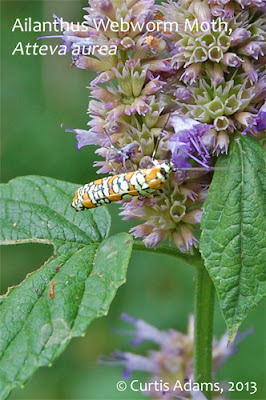 |
| This Virginia Stickseed is about 2 feet tall. The horizontal sprays of seed pods give it a unique texture. |
 |
| Here you can see the progression from flower to burr. This bee fly is a pollinator for many small flowers. Its larvae are parasites that feed on other insects. |
 |
| This plant has a highly branched forms, others in less disturbed areas grow as a single upright stem. |
Nearby was one of my favorite little natives, Indian Tobacco, Lobelia inflata. It is not really showy. The blue flowers are not very big and the small flowers are spaced widely on the stalk. What I think is so cool are the swollen ovaries (hypanthium) that form after the flower fades. This feature is the reason for the species name, inflata. This plant is used as an herbal remedy for many ailments, particularly as an emetic, but it is also quite toxic. I've tried growing these from seed indoors under lights with limited success. It seems to grow better as a 'weed', than as a cultivated plant.
 |
| Here you can see both the pale blue flowers and the inflated hypanthium. |
 |
| The coarsely toothed, oppositely arranged leaves on long petioles are similar to those of nettles. |
White Vervain, Verbena urticifolia, has spikes of tiny white flowers. The plant has a rough appearance with its large, coarsely toothed leaves. The species name uricifolia refers to it having nettle-like leaves. This is not a particularly attractive plant, but its flowers are visited by a variety of bees and its seeds are consumed by birds.
 |
| Here's a closer view of the flowers of White Vervain. It seems like the tips of the flower stalks are the place for small insects to hang out. |
 |
| The current botanical name for this Horseweed is Conyza canadensis. |
When I looked past the white Vervain I saw what thought was more of the same, but on second glance I realized that I had yet another plants with little white flowers. I keyed this one out as Horseweed, Erigeron canadensis, which has been updated as Conyza canadensis. On examination its form is very different from the verbena, with narrow leaves occurring alternately along the stem. The main similarity was that the flower stalks originated from the leaf axils. Similar to members of the genus Erigeron, its flower is composite type with many small rays. This annual is commonly seen in waste areas and fence rows.
 |
| A green sweat bee visiting a Horseweed flower. |
My last plant for this post was discovered with its flower stalk sticking out of some berry vines in a woodland edge habitat. Normally I leave a plant in place until I know what it is, but this one had me worried. It had characteristics of Polygonum (Knotweed) and with its white flowers I immediately thought of Japanese Knotweed. When I brought the cutting in for examination I learned that it was actually a native knotweed, Polygonum virginianum, aka Jumpseed or Virginia Knotweed. It is also known and sold as Persicaria virginiana and Tovara virginiana. This particular specimen had dark green leaves; however many plants have a red chevron on otherwise green leaves.
 |
| This stem got beat up a bit after I pulled it out from a mass of wineberries. I would have left it alone had I known what it was. |











